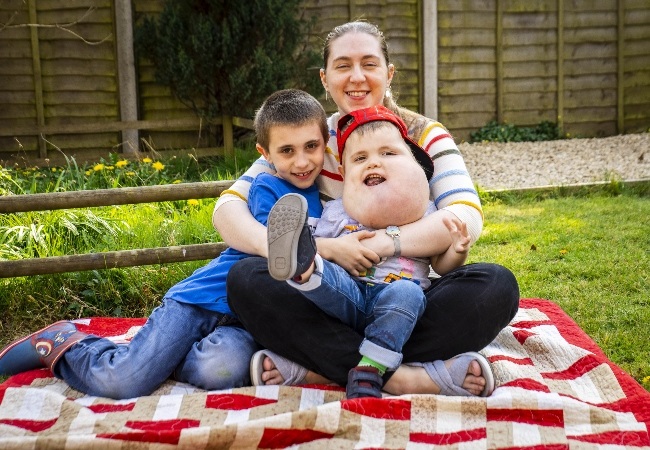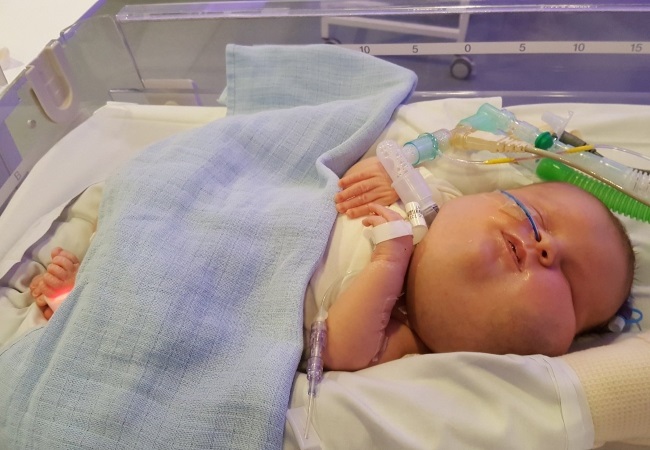
The past few years of the little boy’s life have been tough. He was unable to walk, talk or breathe properly because of cysts the size of a grapefruit located on his face and in his airways.
But Alex Grabowski is one determined kid – and his family have reason to rejoice now. After undergoing multiple surgeries to remove parts of the cysts, the four-year-old from Somerset in England can take a few steps and say a few words.
And to his mother, it’s balm for the soul and music to the ears.
Little Alex was born with cystic hygroma – a fluid-filled sac that results from a blockage in the lymphatic system, most commonly located in the neck or head area.
Alex has undergone eight “debulking” operations over the years, his mom, Emily (35), says.
“The surgeries are still something I’m trying to get used to,” she says. “I cry every time he goes into theatre. The operations can take eight hours, so it’s a long wait.
“One of his cysts is over a nerve that could paralyse his face if they hit it, so they have to be really careful.”
Although the journey has been challenging, Emily says her little boy is making positive strides towards a somewhat normal life.
“Alex has already come on leaps and bounds,” she says. “We’re so proud of him.”
During a routine 20-week scan, Emily, a single mom, was told by doctors that her baby boy would be born with abnormal growths on his face that would keep growing as he got older.
Emily admits she was terrified. “I was scared to know what Alex would look like. There were so many unknowns.”
But when Alex was born in January 2017, weighing a healthy 3,1kg, she fell in love with him immediately.
“As soon as I saw him, I thought he was gorgeous and burst into tears,” she says.
Because of Alex’s condition, which occurs in one in every 6 000 babies worldwide, he spent the first six months of his life at Bristol Royal Hospital for Children, where he underwent his first surgeries to remove some of the cysts on his face and neck.
Emily also had to undergo training on how to take care of her little one before he could be discharged. Looking after Alex on her own was daunting at first, she admits.
“It was suddenly just me. I had to get used to going places with all his equipment,” she says.
But it’s my reality now, she adds. “Caring for him is hard work, but I wouldn’t have it any other way.”
The weight of the cysts on Alex’s face has caused a delay in many aspects of his development. It took him longer to learn to walk and talk because the angle of the cysts made it hard for him to balance and speak.
Because the cysts are also in his airway, Alex must have a tracheostomy to assist him with breathing and has to be fed through a tube. Emily hopes the tube will be removed one day so he can live more independently.
READ MORE | Northern Cape teen born without breastbone makes SA medical history
Alex is a smart little guy, his mom says. He communicates with his family via sign language and has come a long way since birth – and she is over the moon at his development since his recent surgery.
He can walk on his own without losing balance and his speech is improving all the time. His first word was “bubbles” and he can now say “Peppa Pig”, Emily says proudly. He is also starting to form sentences.
“He’s doing amazingly. We still sign with him and he’s very good at getting his point across.”
Although Alex is unbothered about his condition now, Emily, who has another son, eight-year-old Roman, says she’s fearful of the scrutiny he’ll inevitably receive when he’s older.
“Most people are lovely about him but there have been some nasty comments,” she says.
“People have told me he looks scary and one man came up to me and asked me if he was real. I’m worried about him having to deal with it by himself when he is older.”
Emily is grateful for the love and support she’s received from the Rainbow Trust Children’s Charity, an organisation that provides emotional and practical support to families who have kids with life-threatening conditions.
She also has a family support worker who helps her in her home. “Everyone has been amazing about giving me that bit of time to myself or letting me vent to them," Emily says.
Although she’s not sure what the future holds for Alex, who will have more debulking surgeries as the years go by, his mom knows for sure she’ll always be there for him.
“I can only hope his life will get easier,” Emily says. “But I love Alex and I wouldn't change a thing.”
Cystic hygroma is the medical term for abnormal growths that appear on a baby’s neck or head and grow substantially over time.
Although the condition can develop after birth, it is usually present while the fetus is developing in the womb. The condition can increase the chance of miscarriage.
Cystic hygromas sacs, which usually form between the ninth and 16th week of pregnancy, are filled with fluid and caused by blockages in the lymphatic system – a network of organs and tissues that moves fluid around through the body and transports white blood cells.
Growths that form after birth generally become visible around the age of two.
The cysts are usually soft, spongy lumps and can also form in the armpits and groin area. They vary in size – from as small as a coin to as large as a cricket ball – and can affect movement, balance and speech.
Surgery is successful in removing smaller cysts but where the cyst is large – as in Alex Grabowski’s case – doctors refrain from removing it altogether to prevent damaging healthy tissue.
SOURCES: MIRROR, DAILY MAIL, 7NEWS.COM.AU, THE SUN, HEALTHLINE




 Publications
Publications
 Partners
Partners




















